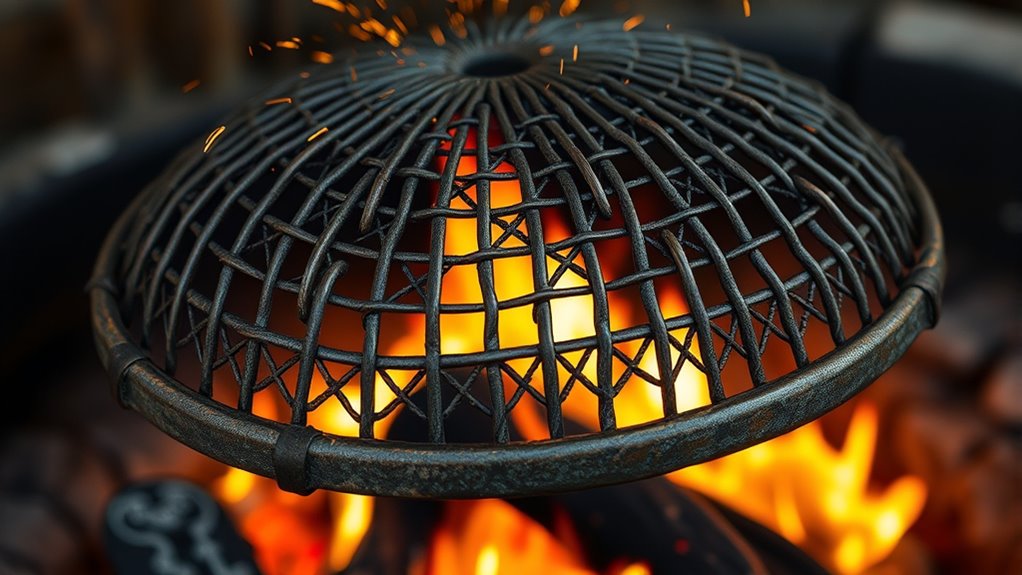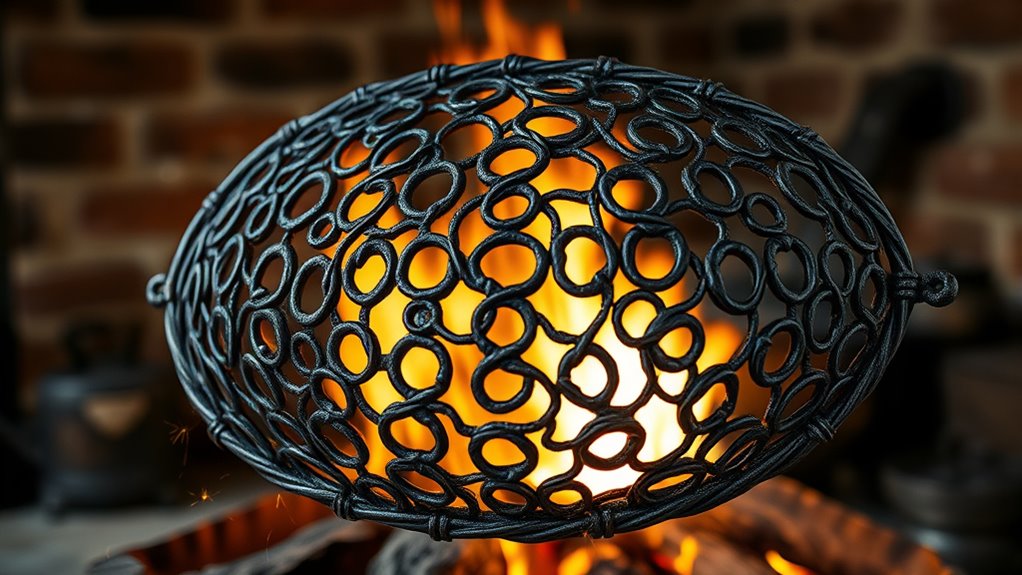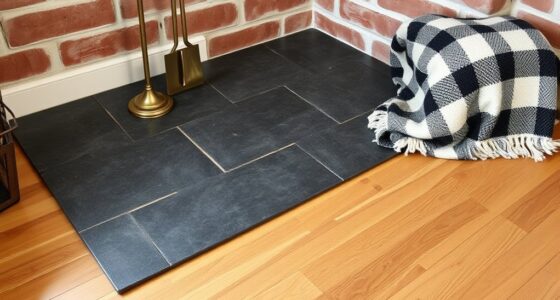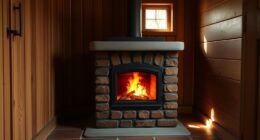To fabricate a spark screen for open hearth cooking, select thick, heat-resistant materials like wrought iron or steel for durability. Measure your hearth opening carefully, adding a small margin for easy fitting. Cut expanded metal or heavy gauge wire mesh to size, then shape or frame it for a snug fit using simple tools like pliers or a grinder. Regularly inspect and maintain the screen to guarantee safety and effectiveness, and discover more tips to craft an effective barrier.
Key Takeaways
- Select durable, heat- and corrosion-resistant materials like wrought iron, steel, heavy gauge wire mesh, or expanded metal.
- Measure the hearth opening accurately, adding margins, then cut materials with appropriate tools for a snug fit.
- Shape or bend materials to match hearth contours and create a stable frame using pliers, hammers, or welding techniques.
- Test the spark screen over the hearth to ensure effective spark containment and proper airflow during use.
- Regularly inspect and maintain the screen, replacing any worn or damaged parts to ensure ongoing fire safety.

Open hearth cooking offers a traditional and flavorful way to prepare meals, but sparks and flying embers can pose safety hazards. That’s why fabricating a spark screen is a practical step to protect yourself and your surroundings. Understanding fire safety and employing historical techniques can help you create an effective shield that preserves the authenticity of open hearth cooking while reducing risks.
Start by selecting the right materials. Historically, blacksmiths used wrought iron or steel for spark screens because of their durability and heat resistance. Modern alternatives include heavy gauge wire mesh or expanded metal, which serve the same purpose effectively. When choosing your material, ensure it’s thick enough to withstand sparks without warping or melting. Remember, safety is paramount, so opt for materials that can handle high temperatures and resist corrosion over time.
Next, measure the opening of your hearth carefully. You want your spark screen to fit snugly without impeding access or airflow. Use a measuring tape to determine the width and height of the opening, then add a small margin to allow for easy placement and removal. Cut your chosen material to size, ensuring clean, straight edges. If you’re using wire mesh, a pair of heavy-duty wire cutters will help you achieve precise cuts. For expanded metal, a metal snip or angle grinder with a cutting disc works well.
Once your pieces are cut, consider shaping or bending the material to conform to the hearth’s contours if necessary. In traditional techniques, smiths often used simple tools like pliers or hammers to shape metal. For a more secure fit, you can create a frame by bending the edges or attaching side supports. This adds stability and ensures the screen remains in place during cooking. If you want a more finished look, you can weld or rivet the edges, but basic fastening with sturdy ties or clips can suffice for a functional screen.
Finally, test your spark screen by placing it over the hearth and observing how well it contains sparks while allowing proper airflow. Always prioritize fire safety—never cook without a spark screen if sparks are likely to escape. Regularly inspect your makeshift screen for signs of wear or damage, replacing parts as needed. Incorporating appropriate materials that are heat-resistant and durable can significantly enhance safety and longevity. By adopting these historical techniques and focusing on fire safety, you create a simple yet effective barrier that preserves the authenticity of open hearth cooking while ensuring a safe environment for your culinary endeavors.
Frequently Asked Questions
What Materials Are Best for Fabricating a Spark Screen?
You should use metal mesh made from heat-resistant materials like stainless steel or expanded metal for your spark screen. These materials can withstand high temperatures and prevent sparks from escaping. Make sure the mesh has small enough openings to catch embers but still allows airflow. By choosing durable, heat-resistant metal mesh, you’ll create an effective spark screen that protects your open hearth cooking area while maintaining good ventilation.
How Do I Ensure Proper Airflow in the Spark Screen?
You might think airflow is just a minor detail, but it’s actually the star of the show. To guarantee proper airflow, pay close attention to ventilation considerations—leave enough gaps in your spark screen for air to move freely. Use mesh that’s not too dense, and test your setup by observing smoke and sparks. Optimizing airflow keeps your fire burning bright and safe, proving that even tiny holes matter big time.
Can a Homemade Spark Screen Be Safely Used With All Fuels?
A homemade spark screen can be safely used with most fuels if you prioritize homemade safety and guarantee its durability. Use sturdy materials like stainless steel or heavy-duty wire mesh to withstand high heat and sparks. Regularly inspect your screen for wear or damage, and avoid using it with highly flammable fuels that could compromise its integrity. Proper construction and maintenance keep your sparks contained safely during open hearth cooking.
How Often Should the Spark Screen Be Inspected or Replaced?
Think of your spark screen as the guardian of your hearth—its vigilance keeps safety intact. You should inspect your spark screen regularly, ideally before each use, to check for signs of wear or damage. Replace it when corrosion, holes, or weakened mesh appear, as these are clear replacement criteria. By maintaining a consistent inspection frequency, you guarantee your open hearth stays safe and efficient, preventing unexpected sparks or fires.
Are There Safety Guidelines for Installing a Spark Screen?
You should follow fire safety guidelines when installing a spark screen to prevent accidents. Make sure the screen fits securely over your hearth opening, avoiding gaps that could let sparks escape. Use proper installation tips, like anchoring the screen firmly and checking for stability before use. Always wear protective gear during installation, and verify the screen is in good condition, replacing it if damaged, to maintain a safe open hearth environment.
Conclusion
Don’t let the idea of building a spark screen intimidate you. With simple materials and straightforward steps, you can craft a reliable barrier to keep sparks in check. Even if you’re new to metalwork, this project is manageable and saves you money compared to buying one. Just take your time, follow the instructions, and you’ll have a sturdy spark screen ready to enhance your open hearth cooking safety and enjoyment.











